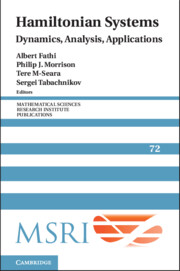Book contents
- Frontmatter
- Contents
- Denjoy subsystems and horseshoes
- Impact Hamiltonian systems and polygonal billiards
- Some remarks on the classical KAM theorem, following Pöschel
- Some recent developments in Arnold diffusion
- Viscosity solutions of the Hamilton–Jacobi equation on a noncompact manifold
- Holonomy and vortex structures in quantum hydrodynamics
- Surfaces of locally minimal flux
- A symplectic approach to Arnold diffusion problems
- Hamiltonian ODE, homogenization, and symplectic topology
- References
Impact Hamiltonian systems and polygonal billiards
Published online by Cambridge University Press: 10 May 2024
- Frontmatter
- Contents
- Denjoy subsystems and horseshoes
- Impact Hamiltonian systems and polygonal billiards
- Some remarks on the classical KAM theorem, following Pöschel
- Some recent developments in Arnold diffusion
- Viscosity solutions of the Hamilton–Jacobi equation on a noncompact manifold
- Holonomy and vortex structures in quantum hydrodynamics
- Surfaces of locally minimal flux
- A symplectic approach to Arnold diffusion problems
- Hamiltonian ODE, homogenization, and symplectic topology
- References
Summary
The dynamics of a beam held on a horizontal frame by springs and bouncing off a step is described by a separable two degrees of freedom Hamiltonian system with impacts that respect, point wise, the separability symmetry. The energy in each degree of freedom is preserved, and the motion along each level set is conjugated, via action angle coordinates, to a geodesic flow on a flat two-dimensional surface in the four-dimensional phase space. Yet, for a range of energies, these surfaces are not the simple Liouville–Arnold tori – these are compact orientable surfaces of genus two, thus the motion on them is not conjugated to simple rotations. Namely, even though energy is not transferred between the two degrees of freedom, the impact system is quasiintegrable and is not of the Liouville–Arnold type. In fact, for each level set in this range, the motion is conjugated to the well-studied and highly nontrivial dynamics of directional motion in L-shaped billiards, where the billiard area and shape as well as the direction of motion vary continuously on isoenergetic level sets.
Keywords
- Type
- Chapter
- Information
- Hamiltonian SystemsDynamics, Analysis, Applications, pp. 29 - 66Publisher: Cambridge University PressPrint publication year: 2024

